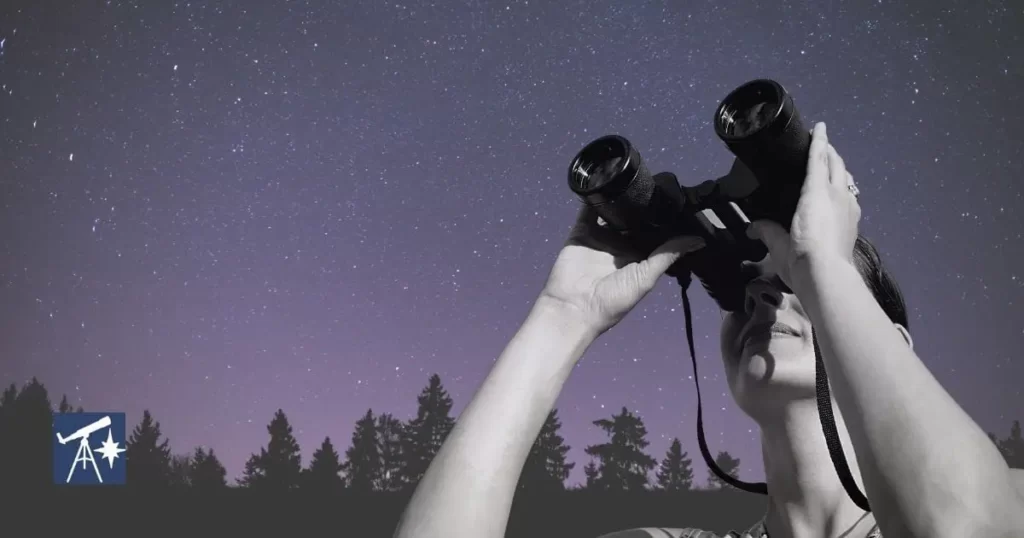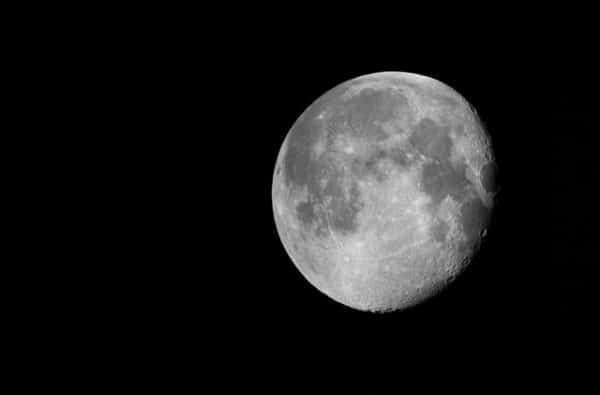There are many reasons to invest in a good set of binoculars for exploring the night sky. With a good pair of binoculars and a clear night sky, you can explore the stars, planets, and galaxies in a whole new way. Here, I cover what to know about using binoculars for stargazing and include tips for making the most out of your experience.

If you’re fascinated with the night sky and are interested in exploring it, using binoculars could be a great option for you. Either in addition to or instead of buying an astronomy telescope.
Binocular means two oculars or eyes. Think of a set of binoculars as two telescopes put together to focus on the same point. The following is a basic overview of how they work.
- Binoculars have two lens elements, one in front of the other, in each scope.
- The lenses capture and bend the light to give you a magnified view of what you are looking at.
- The second lens, the smaller one, is the ocular that you look through and it magnifies the image produced from the first lens.
- The binoculars have a prism (a roof or a Porro prism) between these that rotates the image. Find out about prism glass BAK4 vs BK7 types. — So what you see is an image the right way up.
Benefits of using binoculars for stargazing
Binoculars can also be used in land and sea activities as well as astronomy. All up, they are a cost-effective option for kids, beginners, and anyone keen on adventure.
By using them, you can immerse yourself in a more complete stargazing experience.
When it comes to choosing the right binoculars for stargazing, there are several considerations to keep in mind. For example, you need to think about the magnification and aperture size of the binoculars, as I explain in my article on finding the perfect binoculars for stargazing.
Astronomy binoculars vs telescope
Binoculars are not only portable and easy to use.
Compared to a telescope, binoculars for astronomy are compact and portable and there’s no effort in setting them up.
With binoculars, you’ll get to see enough of the sky to find your target celestial object easier than you would with a telescope. This is because binoculars offer a wider field of view compared to a telescope — helping with orientation.
Apps with augmented reality of the night sky will help you locate celestial objects and with binoculars, you’ll get better acquainted with the night sky.

Orion 10×50 Wide-Angle (affiliate link)
What can you see with astronomy binoculars?
With a good set of astronomy binoculars, expect to see features on the Moon but also larger objects like the double cluster in Perseus and star clusters of the Pleiades and Hyades.
Galaxies are also one of the astronomical objects you can see in binoculars better than a telescope, as you will see the object in context, with the black sky around it.
15 objects to Find in the night sky with your astronomy binoculars:
- The Moon – observe the lunar craters, mountains, and maria with your binoculars
- The Orion Nebula – a stunningly beautiful emission nebula.
Look for it in the constellation of Orion. - The Andromeda Galaxy – our nearest neighboring galaxy, is visible as a faint smudge in the sky.
- The Pleiades – a bright open cluster of stars. It is known as the Seven Sisters and the subject of traditional people’s stories. Look for it in the constellation of Taurus.
- The Hercules Cluster – a globular cluster of stars. Look for it in the constellation Hercules.
- The Great Cluster in Perseus – another bright open cluster of stars. You’ll find it in the constellation Perseus.
- The Ring Nebula – a planetary nebula in the constellation Lyra.
- The Double Cluster – a pair of open clusters in the constellation Perseus
- The Beehive Cluster – another open cluster of stars in the constellation Cancer
- The Veil Nebula – a supernova remnant in the constellation Cygnus
- The Lagoon Nebula – an emission nebula in the constellation Sagittarius
- The Trifid Nebula – another emission nebula in the constellation Sagittarius
- The Whirlpool Galaxy – a spiral galaxy in the constellation Canes Venatici
- The Eagle Nebula – an emission nebula in the constellation Serpens
- The North America Nebula – another emission nebula in the constellation Cygnus, shaped like the continent of North America.
For an expanded list, see my article on 25 Things to See In The Night Sky With Binoculars.
Looking through binoculars

Tips on using binoculars to explore the night sky
To get the most out of your stargazing experience, here are some helpful tips to keep in mind…
- Find a location away from light pollution: To see the stars in all their glory, you need to be away from city lights and other sources of light pollution. Try to find a spot that is as dark as possible.
- Use a star chart: A star chart or planisphere can help you identify constellations and other celestial objects in the night sky. It’s a handy tool to have with you when stargazing.
- Bring a comfortable chair or blanket: Stargazing can be a relaxing activity, and you’ll want to be comfortable while you do it. Bring a chair or blanket to sit on, and consider bringing some snacks and drinks as well.
- Look for special events: Keep an eye out for special astronomical events, such as meteor showers or eclipses. These can be especially exciting to watch. I have an article on optimizing your view of meteor showers. And I also wrote tips on observing solar eclipses.
Here are some additional tips to help you find the best location for stargazing with binoculars:
- Check the weather forecast: Even if you find a great location, cloudy or hazy skies can ruin your stargazing experience. Be sure to check the weather forecast before heading out to ensure that the skies will be clear.
- Consider the Moon phase: The phase of the Moon can greatly impact your stargazing experience. A full moon can make it difficult to see fainter stars and objects, so try to plan your stargazing trip around a new moon or a moonless night.
- Bring a comfortable chair or blanket: Stargazing can require a lot of patience, so it’s important to be comfortable while you wait for the stars to come out. Bring a chair or blanket to sit on, and consider bringing along some snacks and drinks to keep you fueled up.
By taking these factors into account, you’ll be able to find the perfect location for stargazing with binoculars and enjoy an unforgettable observing experience.
Adjusting and setting up the binoculars
When stargazing with binoculars, you need to adjust them to suit your eyes in both vision and distance apart.
Hold the binoculars up to your eyes and look at a distant object, then adjust the focus wheel until the object is in sharp focus.
You will also need to adjust the distance between the lenses to match the distance between your eyes.
This will help you see a clear and comfortable image of the stars, except you’ll need to keep the binoculars steady.
I elaborate on this in my article on how you can hold binoculars steady for night sky exploring. This can include using a tripod with your binoculars to lying on your back in an inflatable pool bed to other more makeshift ways.
With practice, you will be able to identify constellations, stars, and other celestial objects with ease.
Allow eyes to adapt
Allowing your eyes to adapt to night vision is crucial for stargazing with binoculars. You need a little patience as it can take up to about 20-30 minutes to get to full effect. During this time avoid looking at bright lights or using electronic devices.
To aid in this process, try using a red light or cover over a flashlight instead of a conventional white light, as it is less disruptive to your night vision.
Once your eyes have adapted, you’ll be able to see more stars and details in the night sky, making for a more enjoyable stargazing experience.
With a little practice and patience, you’ll soon be able to appreciate the beauty of the night sky with your binoculars.
